Flow Lifecycle
Botpress uses what we call the Dialog Engine to handle conversations, which is responsible of every interaction. It handles the user input and the chatbot response.
The Dialog Engine uses Flows representing a chatbot's overall conversational logic. A Flow is then composed of Nodes which execute a series of Instructions. Instructions are part of a Node lifecycle and can execute actions. An action is a code snippet, usually code that you have written yourself, code provided by Botpress or others.
Flows
A workflow allows you to break down a complex chatbot into multiple smaller flows. Breaking down the chatbot into multiple flows makes it easier to maintain, and you can re-use these flows when building other workflows or even other chatbots.
Let's look at our Botpress support bot Blitz. We can add three flows to handle issues, tickets, and troubleshooting.
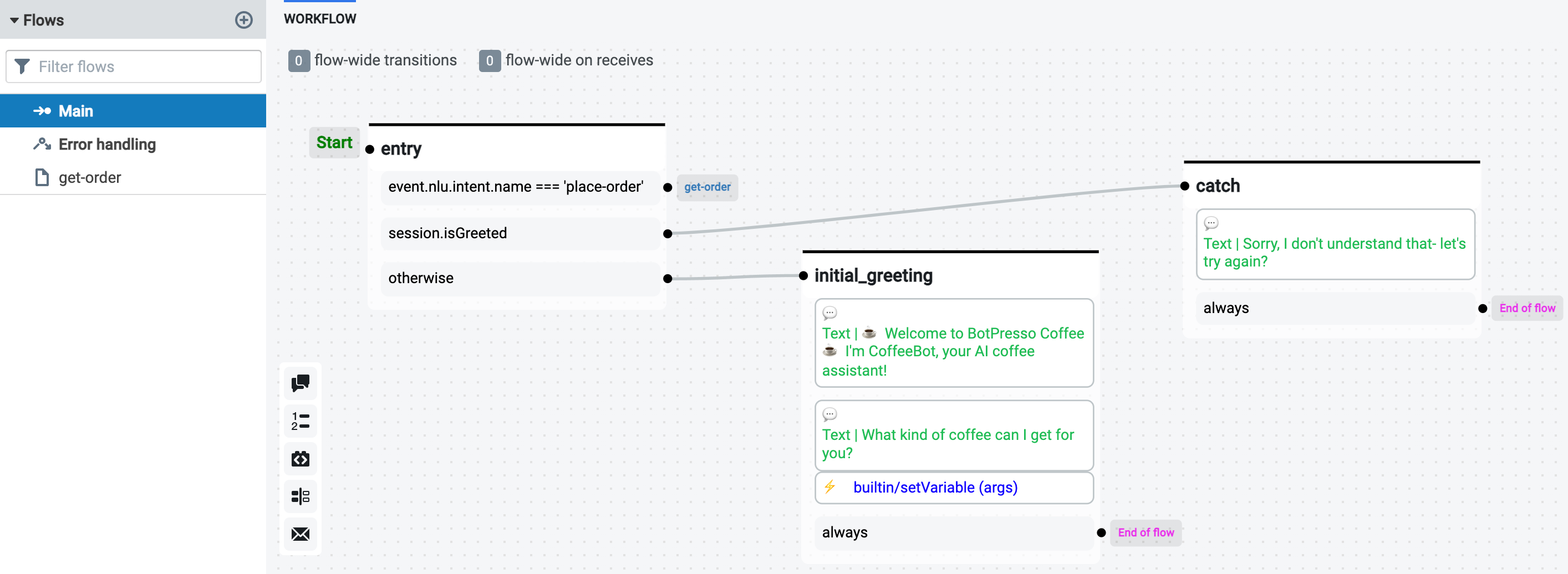
Flow Lifecycle
A flow always starts at the startNode of its *.flow.json file, with the Main flow being the first to be executed at the beginning of each conversation. The start node points to the node which is to be executed first by name. Once the node is selected, the Dialog Engine will queue the active node's instructions and execute the instructions sequentially.
The Dialog Engine is event-based and is non-blocking by default, which means that a flow will execute all it can manage until it needs to wait.
note
There are currently two reasons for a flow to "wait":
- A node is marked as waiting for user input;
- A node couldn't match a condition to transition to another node;
- A node has no transition instruction.
Once the first node is processed, the Dialog Engine will proceed to the next node in the flow until it reaches the very end. Flows are pretty straightforward. Nodes also have a lifecycle of their own. They do the heavy lifting in a flow.
Storage
Flows are stored as JSON files in the chatbot's source files. In the context of this tutorial, the flows are stored in the data/bots/blitz/flows/ folder. Each flow is split into two files: the logic (*.flow.json) and the visual-specific properties (*.ui.json). The reason to split these is to make it easier to maintain and review changes.
*.ui.jsonfiles can almost always be ignored from code reviews as they don't affect the chatbot's functionality.*.flow.jsonfiles could also, in theory, be created manually by developers instead of using the GUI. This is the case for Skills, which we will cover later.
Nodes
Nodes are the primary units of the conversational logic of your chatbot. An active conversation (which we call a session) always has one and only one active node. A node generally transitions to another node or flow. When there aren't any more transitions, the conversation ends. The following message from the user will then be part of an entirely new session.
A node is separated into three different stages: onEnter (A), onReceive (B) and onNext (C).

On Enter
onEnter is a list of instructions executed when the node is entered. If multiple actions are defined, your chatbot will execute all of them sequentially.
On Receive
onReceive is a list of instructions executed when the node receives a message from the user while it is active. As soon as an action is defined, the node will automatically be waiting for user input (orange node).
When this property is left unused, the node is non-blocking (black), which means it will flow straight from the onEnter to the onNext.
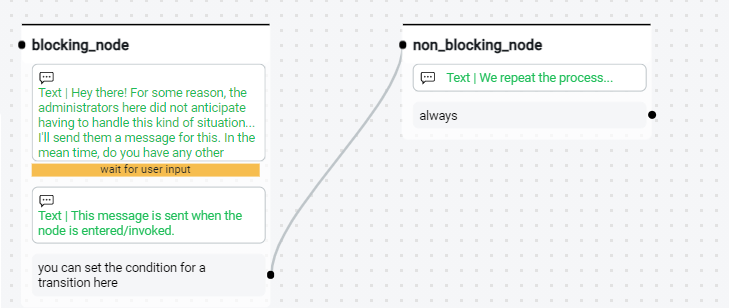
onNext
onNext (also called Transitions) is precisely the same thing as Flow-wide Transitions except that the conditions are only evaluated after onReceive or onEnter have been executed.
Special cases
- If no condition is defined, the default behavior is the end of the conversation.
- If there are conditions defined but none match, nothing happens. The current node stays active and will flow when a condition is matched. By default, the
onNextwill only be retried afteronReceiveis re-invoked.
A Transition always has a target that we call a Destination. It can be:
- A different node;
- A different flow;
- The previous Fflow;
- Itself (loopback on itself);
- The end of the conversation.
State
Each conversation has an associated State. The state is created when the conversation session is started and is destroyed when the session is ended.
A state is created just before the entry node is entered.
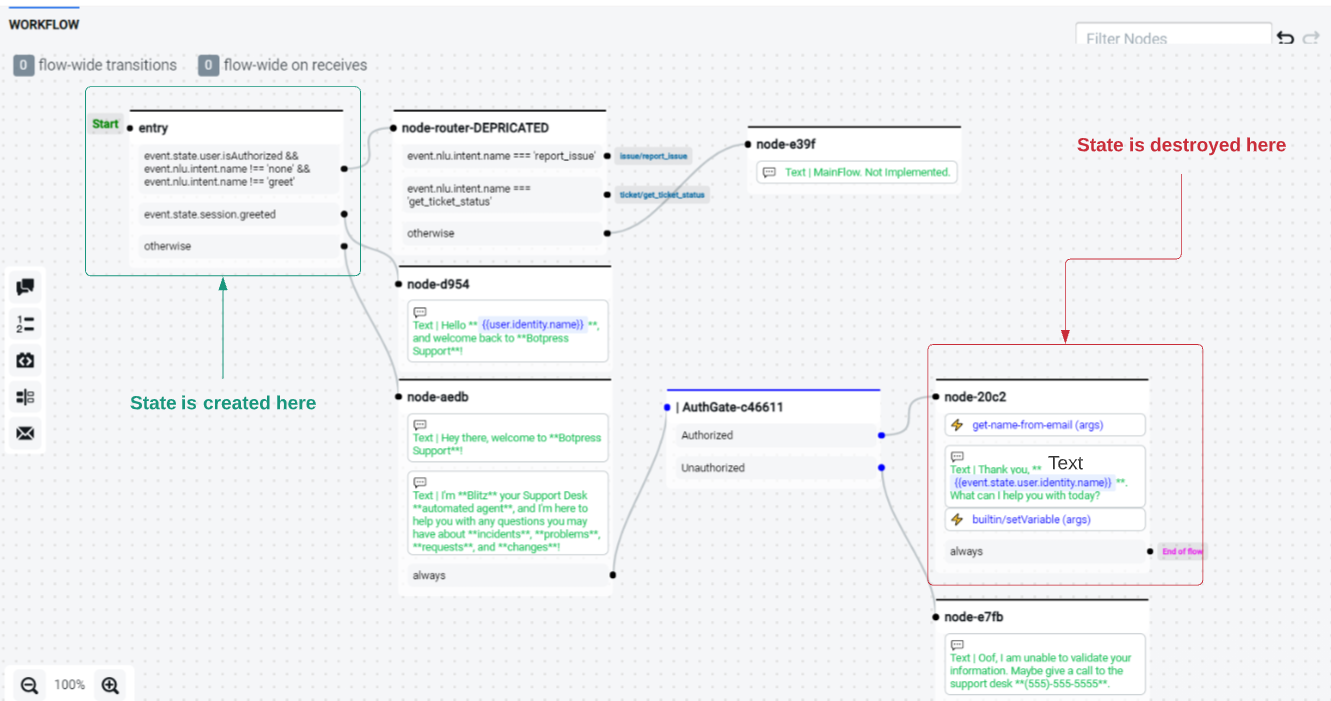
note
The state is global to the conversation, so if the conversation spans multiple flows, they will all share the same state.
Session Timeout
The Dialog Engine will wait for the input of a user. After a while, if the user does not respond, the session will Timeout.
Timeout allows you to end the conversation gracefully if needed. It can also be helpful to do some processing before deleting the session. For instance, you could save the user contact information to an external database, or tell the user how to contact you or inform the user his session has timed out.
Timeout Flow
You can use a Timeout Flow to handle your timeout logic. It works just like a regular flow. All you have to do is add a Flow called timeout.flow.json to your chatbot and specify a start node. Then, the Dialog Engine will detect your Timeout Flow next time a user times out.
Timeout Node
Very similar to the Timeout Flow, the Timeout Node should be called timeout and should belong to the current flow. You don't have to link it to any other node. The Dialog Engine will detect the node based on its name.
Timeout Transition
Another option that requires some coding is to add the property timeoutNode to your *.flow.json file and assign it to the name of the node that should handle the timeout. Again, it can be any node; it doesn't need to be called a particular way.
caution
Once the Dialog Engine has processed the timeout, it will delete the session.
Actions
An Action is JavaScript code that is executed in a Node.js VM. It can be anything you want: call an API, store something in the database, or store something in the Key-value Store. Actions are called by onEnter and onReceive instructions. There are two types of actions:
- Script: a user-defined Action that is used to run custom code.
- Output: an output Action that is used to make a chatbot output something.
note
To learn more on actions, please refer to the Code Editor section.
Skills
After building a couple of flows/bots, you'll quickly notice that there are some common patterns that you find yourself implementing over and over. Skills come to the rescue.
Skills are higher-level abstractions on top of flows that serve as dynamic flow generators.
They can be seen as reusable components between multiple flows or even multiple chatbots.
Installing skills
A module must expose every skill. Modules can host any number of skills. All you need to do is install the required module, and you will have access to its skills.
Using skills
Skills are meant to be used by the Botpress Flows GUI. After
- Install the desired skill module.
- Navigate to the selected flow.
- Locate the Insert Skill toolbar at the left of the flow builder interface.
- Select your skill.
- Fill in the form.
- Click anywhere in the flow to insert the skill.
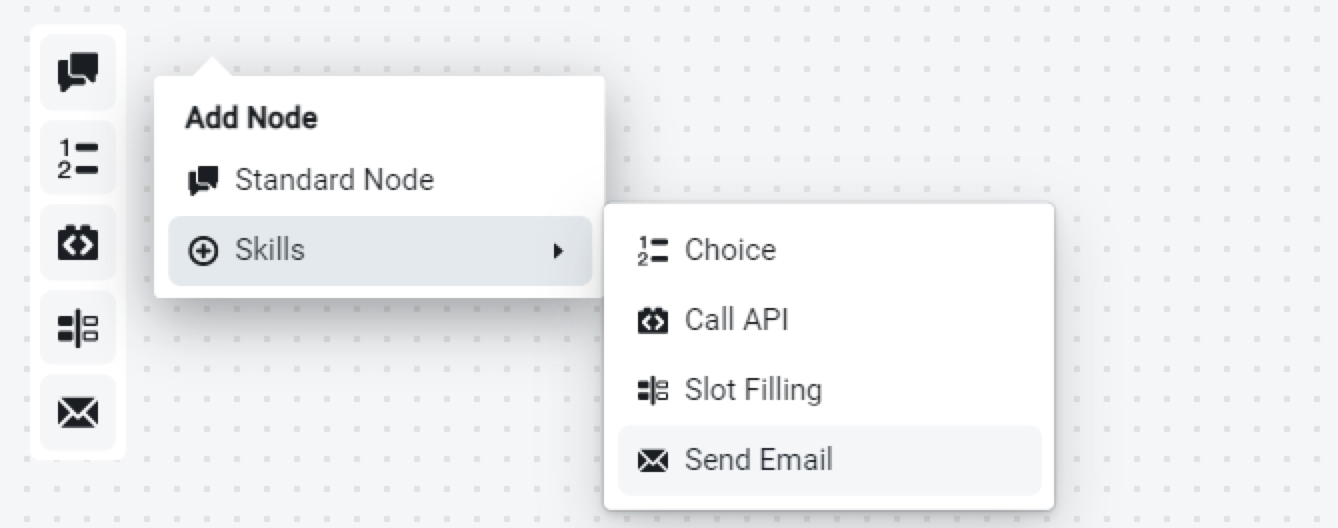
Persistence
Skills are stored as flows under the data/bots/your-bot/flows/skills folder. Skill nodes in the Studio Interface have the name of the skill appended to the node name, making them easily identifiable.
Editing skills
Once a skill node has been generated, you may click on that node and click Edit on the right panel to edit that node, which will update the generated flow automatically behind the scenes.
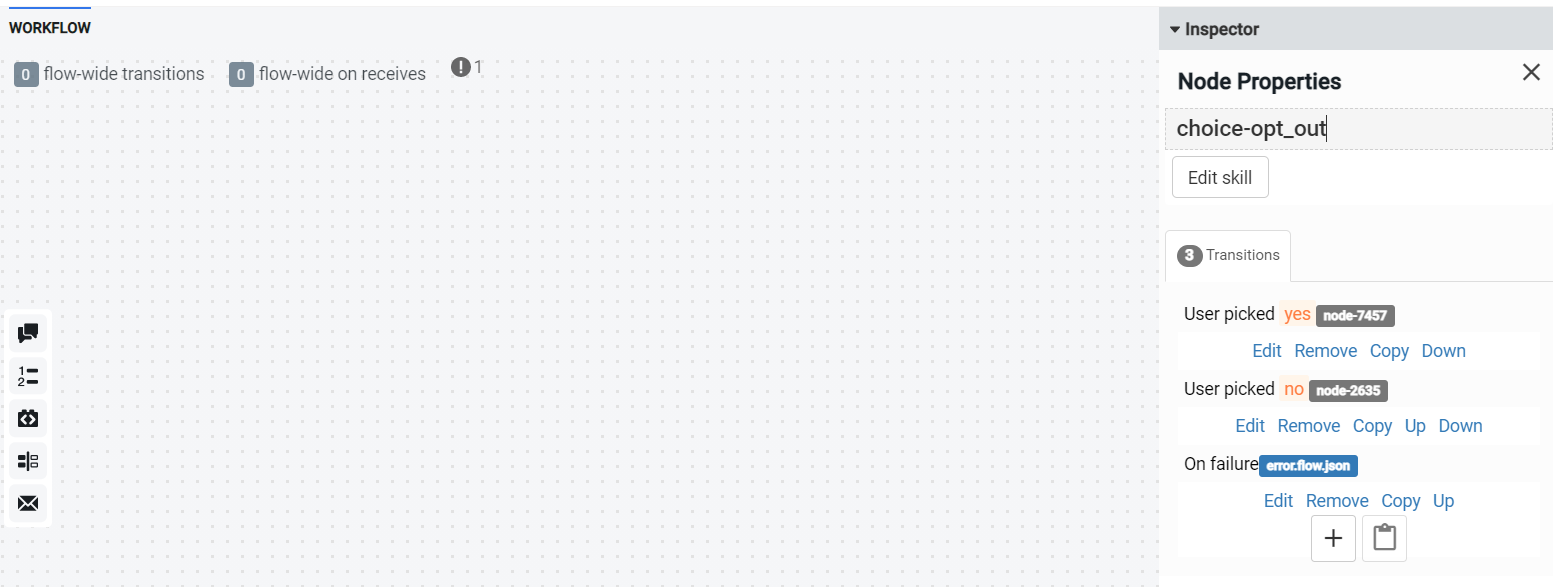
note
While you can rename your skill to any name you want, it is considered best practice to append the skill type to the node name, for example, choice-choose-topping.